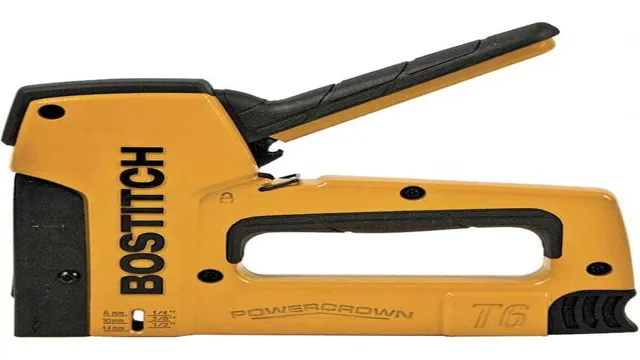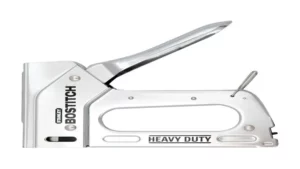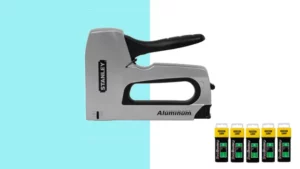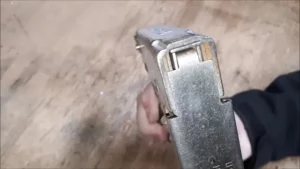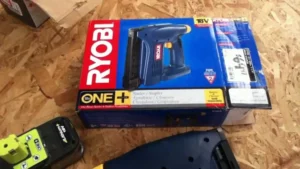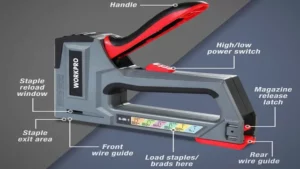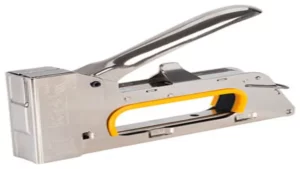If you’re used to using a standard staple gun, loading a Bostitch staple gun can seem like a bit of a daunting task. However, with the right guidance and a little bit of practice, it’s actually a pretty straightforward process. In this blog post, we’ll take you through the step-by-step instructions for loading a Bostitch staple gun, so you can get back to your project in no time.
Whether you’re a DIY enthusiast or a professional contractor, mastering the art of loading a Bostitch staple gun could be the difference between a job well done and a job done poorly. So, let’s get started!
Preparing the Staple Gun
If you’re wondering how to load a Bostitch staple gun, don’t worry – it’s a fairly straightforward process! First, make sure that your staple gun is disconnected from any power source, and clear it of any remaining staples. Next, release the magazine latch which will allow you to slide the staple magazine out of the base of the gun. Load the magazine with the correct size and type of staple for your project, making sure not to overfill it or jam any staples.
After reloading the magazine, slide it back into the gun until it clicks into place and secure the magazine latch. Finally, reconnect the power source if needed, and you’re ready to start stapling! With these simple steps, you’ll be able to confidently load your Bostitch staple gun in no time.
Check the Staple Size
Before you start using a staple gun, it is important to check the staple size that it can handle. Using the wrong staple size can damage the gun or not produce the desired results. To prepare your staple gun, first, determine the type of material you will be working with and the thickness of the material.
This will help you select the best staple size for the job. When choosing staple sizes, consider the crown width, leg length, and wire gauge. Always refer to the manufacturer’s instructions to ensure that you are using the correct staple size with your gun.
By taking the time to check the staple size, you can ensure that your staple gun will work efficiently and effectively, producing neat and tidy results every time.
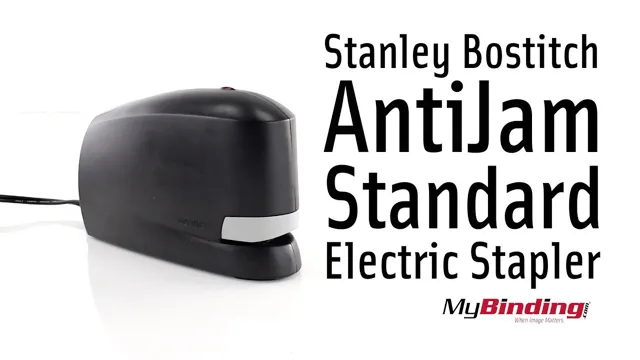
Load the Staples
Before you start using a staple gun, you need to prepare it by loading the staples. This process ensures that the gun is ready for use and avoids any frustrating jamming or misfiring. Firstly, make sure you have the correct size and type of staples for your gun.
You can check the manufacturer’s instructions or packaging for specific information. Once you have your staples, locate the staple compartment on your gun. Usually, this can be found at the base of the gun’s handle or on the top near the trigger.
Remove any old staples or debris from the compartment before inserting the new ones. You can do this by using a small pair of pliers or a staple remover. Insert the staples in the correct orientation, usually with the pointed end facing forward.
Finally, ensure the staple compartment is securely closed before testing your new staples by firing a few test shots into a scrap piece of material. By following these steps, you will have a fully prepared staple gun, ready for any task you require it for.
Inserting the Staples
Staple guns can be a handy tool to have on hand, especially when it comes to DIY projects or home repairs. However, for those who are new to using a staple gun, the loading process can be a bit confusing. So, how do you load a Bostitch staple gun? First, make sure your staple gun is unplugged, and then locate the pusher rod at the front of the gun.
Slide the pusher rod as far back as it will go, and then insert the staples with the pointed ends facing down. Once the staples are in place, carefully release the pusher rod, and you should hear a click indicating that the staples are locked into place. It’s that simple! Just be sure to only use the correct type and size of staples for your staple gun to ensure optimal performance.
Open the Magazine
When it comes to putting together a magazine, there are a lot of steps involved. One of the most crucial is inserting the staples that will hold all of the pages together. It might sound simple, but getting the right placement and alignment for the staples can make or break the final product.
You don’t want them too close to the edge, where they might rip the paper, but you also don’t want them too far in, where they might be difficult to read. Finding the right balance takes some practice, but it’s worth it to ensure that your readers can enjoy flipping through your magazine without any frustrating mishaps. Plus, once you get the hang of it, inserting staples can be almost therapeutic, allowing you to take pride in the tangible results of your hard work.
Insert the Staples
Inserting the staples into a staple gun can be a bit tricky, but with a little bit of practice and skill, you can easily achieve it. Begin by opening your staple gun and loading it with the correct size staples. It is important to double-check the size of your staples before inserting them to avoid any jams or misfires.
Once the staples are loaded, place the staple gun firmly against the object or material you need to fasten. Squeeze the trigger slowly and steadily to fire the staple into place. Take care not to apply too much pressure, as this can damage the material or cause the staple to become misaligned.
With a little bit of practice, you’ll be able to insert staples with ease and speed. Remember to always follow proper safety precautions when using a staple gun, such as wearing protective gear and keeping your fingers clear of the firing zone. By following these guidelines, you can get the job done quickly and efficiently.
Close the Magazine
When it comes to closing a magazine, inserting the staples is a crucial step in ensuring that the publication stays together. After all the pages have been aligned, the next step is to use a stapler to carefully insert the staples along the binding. It’s essential to put just enough pressure to secure the pages together, but not so much that the staples bend or become misaligned.
One important consideration is to make sure that the staples are inserted at the correct depth to ensure that they won’t interfere with the readability of the content or leave any sharp edges. It may take a little bit of practice, but once you get the hang of it, inserting staples quickly becomes second nature. So, just remember to take your time, get the right depth, and voila! You have a newly-bound magazine that’s ready to be enjoyed by readers.
Testing the Staple Gun
If you’re new to using a Bostitch staple gun, loading it may seem like a daunting task. However, it’s actually quite simple once you know how to do it. To start, make sure the staple gun is unplugged and unloaded.
Next, locate the release latch and push it towards the back of the gun to open up the staple magazine. From there, insert the strip of staples into the magazine, making sure they’re facing the right way. Once that’s done, push the magazine back up until you hear a click, indicating that it’s securely in place.
Finally, plug in the staple gun, press it against the material you want to staple, and squeeze the trigger. And just like that, you’re ready to go!
Insert the Power Source
Now that you have the power source for your staple gun, it’s time to test it. We highly recommend testing the staple gun on a scrap piece of material before attempting any actual projects. This way, if there are any issues with the staple gun, you won’t ruin your actual project.
To test the stapler, simply insert your chosen staples into the gun and press down on the trigger. The staple should successfully exit the gun and puncture the scrap material. If this is successful, try stapling a few more times to ensure consistency.
If the stapling is inconsistent or the staples are bent, it may indicate that the staples are not the correct size for your staple gun. It’s better to discover any issues during the testing phase rather than in the thick of a project. Remember, safety is key when using any sort of power tool, so be sure to follow all safety guidelines recommended by the manufacturer.
Test the Staple Gun on Scrap Material
When using a staple gun for the first time, it’s best to test it out on scrap material before moving onto your actual project. This allows you to get comfortable with the tool, understand how it works, and make any necessary adjustments. To begin, choose a piece of scrap material that is similar to the material you will be working on.
Load the staple gun with the appropriate size and type of staple for your project. Then, hold the staple gun firmly against the scrap material and squeeze the trigger to release a staple. Check to see if the staple has gone in straight and flush with the material.
You can also test the depth of the staple by using different pressure on the trigger. By taking the time to test the staple gun on scrap material, you can increase your accuracy and confidence when completing your final project.
Conclusion
Just like loading a Bostitch staple gun, life can be full of twists and turns. It may seem confusing and complex at first, but with a little patience and understanding, you’ll get the hang of it. Just follow the instructions step by step, and don’t be afraid to ask for help if you need it.
Remember, loading a staple gun may seem like a small task, but it can have a big impact in the long run. So take your time, stay focused, and soon enough you’ll be stapling like a pro!
FAQs
What types of staples can be used with a Bostitch staple gun?
Bostitch staple guns can be used with a variety of staple sizes and types, including heavy-duty staples and brad nails. Make sure to check the product manual for recommended staple sizes.
How do you load staples into a Bostitch staple gun?
First, make sure the staple gun is unplugged or unloaded. Then, locate the magazine release button on the bottom of the staple gun and press it to release the magazine. Load the staples into the magazine, making sure they are facing the correct direction. Finally, reinsert the magazine into the staple gun until it clicks into place.
How can you troubleshoot a jammed Bostitch staple gun?
If your staple gun becomes jammed, make sure to first unplug or unload the tool. Then, remove any jammed staples or debris from the magazine and feed area. Check for any damaged parts, and make sure all components are correctly aligned. Finally, reassemble the staple gun and test it with a few staples.
Can you use a Bostitch staple gun for upholstery?
Yes, Bostitch staple guns can be used for upholstery projects. Make sure to choose the correct size and type of staples for your project, and practice on scrap materials before starting your project.
How do you adjust the driving depth on a Bostitch staple gun?
To adjust the driving depth, locate the depth adjustment screw on the side of the staple gun and use a screwdriver to adjust it. Turning the screw clockwise will increase the driving depth, while turning it counterclockwise will decrease it.
What safety precautions should you take when using a Bostitch staple gun?
Always wear appropriate safety gear, including eye and ear protection. Keep your hands clear of the magazine and trigger area, and make sure the tool is unplugged/unloaded before performing any maintenance. Use caution when handling staples, and never point the staple gun at anyone.
What is the warranty for a Bostitch staple gun?
The warranty for a Bostitch staple gun varies depending on the model and purchase date. However, most Bostitch tools come with a one-year warranty against defects in materials and workmanship. Make sure to register your tool with Bostitch to take advantage of warranty coverage.
